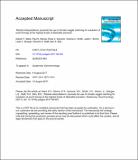Files in this item
‘Radical interpretations’ preclude the use of climatic wiggle matching for resolution of event timings at the highest levels of attainable precision
Item metadata
| dc.contributor.author | Mark, Darren F. | |
| dc.contributor.author | Renne, Paul R. | |
| dc.contributor.author | Dymock, Ross C. | |
| dc.contributor.author | Smith, Victoria C. | |
| dc.contributor.author | Simon, Justin I. | |
| dc.contributor.author | Morgan, Leah E. | |
| dc.contributor.author | Staff, Richard A. | |
| dc.contributor.author | Ellis, Ben S. | |
| dc.date.accessioned | 2018-08-29T23:33:45Z | |
| dc.date.available | 2018-08-29T23:33:45Z | |
| dc.date.issued | 2017-10 | |
| dc.identifier | 251006696 | |
| dc.identifier | 16a99930-7b2f-4b59-b80f-94c810fd091e | |
| dc.identifier | 85029158895 | |
| dc.identifier | 000413383600006 | |
| dc.identifier.citation | Mark , D F , Renne , P R , Dymock , R C , Smith , V C , Simon , J I , Morgan , L E , Staff , R A & Ellis , B S 2017 , ' ‘Radical interpretations’ preclude the use of climatic wiggle matching for resolution of event timings at the highest levels of attainable precision ' , Quaternary Geochronology , vol. 42 , pp. 60-62 . https://doi.org/10.1016/j.quageo.2017.08.003 | en |
| dc.identifier.issn | 1871-1014 | |
| dc.identifier.other | RIS: urn:EE9813BEF0A4F6E2A9DD8483F78D9503 | |
| dc.identifier.uri | https://hdl.handle.net/10023/15904 | |
| dc.description.abstract | An age model (Mark et al., 2017) for ODP 758 and the Matuyama-Brunhes boundary transition and Termination IX in the equatorial Indian Ocean is robust and accurate. No significant magnetic lock-in delay is evident at the depth of the Matuyama-Brunhes boundary and the study highlights that 40Ar/39Ar geochronology is critical for dissection of the Pleistocene at the highest levels of temporal precision and minimal model-dependence. Testing of leads and lags in global-scale climate response requires independently dated timescales to reveal the fine-detail recorded by the various climate archives. | |
| dc.format.extent | 407750 | |
| dc.language.iso | eng | |
| dc.relation.ispartof | Quaternary Geochronology | en |
| dc.subject | GE Environmental Sciences | en |
| dc.subject | T-NDAS | en |
| dc.subject.lcc | GE | en |
| dc.title | ‘Radical interpretations’ preclude the use of climatic wiggle matching for resolution of event timings at the highest levels of attainable precision | en |
| dc.type | Journal article | en |
| dc.contributor.institution | University of St Andrews. School of Earth & Environmental Sciences | en |
| dc.contributor.institution | University of St Andrews. School of Geography and Geosciences | en |
| dc.identifier.doi | https://doi.org/10.1016/j.quageo.2017.08.003 | |
| dc.description.status | Peer reviewed | en |
| dc.date.embargoedUntil | 2018-08-30 |
This item appears in the following Collection(s)
Items in the St Andrews Research Repository are protected by copyright, with all rights reserved, unless otherwise indicated.

